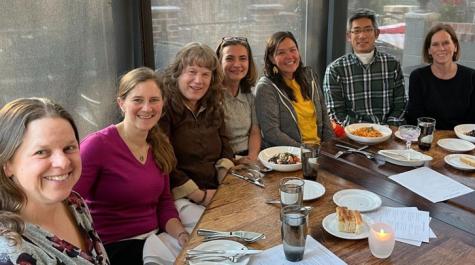Team earns second NSF Grant to promote computational thinking in the classroom
Gladys Krause, William & Mary assistant professor of bilingual and mathematics education, has continued an innovative and successful collaboration with colleagues Maggie Vanderberg, Eva Skuratowicz, and Eping Hung from Southern Oregon University, and with Jill Hubbard from Oregon State University-Cascades. Their consecutive National Science Foundation (NSF) grants, part of the “Computer Science for All” program, promote computational thinking (CT) in the classroom.
Computer science typically applies CT to reduce complex problems to smaller and more manageable elements. But Krause and her colleagues have found that elementary teachers can utilize CT as a novel framework for teaching and analyzing other content areas, such as narrative structures in literature and writing, or participant roles in historical contexts. With CT, educators can provide a structural approach for students in elementary school classrooms to parse language and content when they endeavor to problem solve. This helps students not only to break seemingly complex problems down into tasks they can more easily see how to handle, but it also provides concrete ways of working with language structures and their roles in problem solving.
Computational thinking can provide important additional support to students learning English as they learn other content. Embedding CT into the elementary curriculum to support teaching and learning, especially where environments support multiple languages, began with a 2019 grant. Krause and colleagues worked with teachers to integrate CT into the elementary education curriculum by collectively designing lesson plans incorporating CT elements commonly known as PRADA (Pattern Recognition, Algorithms, Decomposition, and Abstraction).
After the successful conclusion of the first study, Krause and colleagues are now working to expand the use of CT in the classroom with a new grant from the NSF. For this work, they have a three-year plan, beginning with the development of a teacher-leader cohort, comprising teachers not only experienced in incorporating CT into classroom instruction, but also able themselves to train other teachers and thereby to expand the grant’s impact. Oregon public school teachers Trish Dorr, Dylana Garfas, and Jennifer Mohatt from the first study have continued to collaborate with the integration of CT across the elementary school curriculum. The leadership and commitment of these three teachers have been critical to the establishment, continuation, and expansion of a research-practitioner partnership.
“It is amazing to see how the teachers from the last grant are still incorporating computational thinking and remain enthusiastic to learn more,” Krause comments. “It is encouraging to see them in their classrooms using what they have learned.”
“There is a level of excitement and engagement for the work we are doing to improve teaching practices, and the future of our students is always present when we meet,” adds Mohatt.
Still in year one of the new grant, Krause and colleagues will recruit a second group of 18 Oregon elementary school teachers this summer from the Phoenix-Talent and Ashland school districts to develop their skills in CT, with Dorr, Garfas, and Mohatt acting as group facilitators. The goal for next year is to have all teachers incorporate CT into their instruction. During the third year, the team will help to cultivate new group facilitators who can serve as CT teacher-leaders with future cohorts implementing CT.
The use of CT in classroom instruction yields a number of benefits, including a broadening of tools to teach language through content, a fostering of problem-solving and critical thinking skills in ways that transcend individual disciplines, and a more thoroughgoing integration of computer science skills into the curriculum. The work seeks to further from an early age a familiarity with modes of thinking prized in STEM fields, but in content areas stereotypically viewed as distinct from those fields, and thus to provide points of entry for a wide range of students to participate in STEM fields. As a result, the longer-term goals of this work include the potential for increased diversity in the STEM workforce.
Garfas further comments on the benefits for both teachers and students: “The teachers who will complete the computational thinking summer institute and training will benefit by learning about what it is and how to integrate it into their lessons, as well as be able to confidently identify computational thinking components that are currently used in their lessons. The students will also benefit from learning about computational thinking by recognizing it in their daily lives and having background knowledge and foundational training, should they decide to take computer science courses in the future.”
For the teachers and professors involved, the collaborative nature of this work has been a highlight of the experience: “The most rewarding part of this work so far has been the level of collaboration among the participants. Among teachers, professors, researchers, administrators, research analysts, and more, I have been able to network and build important relationships that have benefited me both professionally and personally,” shares Mohatt. “I hope this grant work will encourage more researcher-teacher collaboration in the future, so that educators can be more involved and informed as new discoveries come to light in the science of teaching and learning.”
Similarly, Krause has found the researcher-practitioner partnership incredibly rewarding. “Through research and practice, we have been able to identify problems and work together to solve them.” It is their hope that this special combination of researchers and practitioners could lead to a better future for educators.

